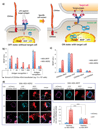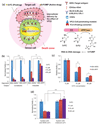Nonimmune cells equipped with T-cell-receptor-like signaling for cancer cell ablation
- PMID: 29131143
- PMCID: PMC5730048
- DOI: 10.1038/nchembio.2498
Nonimmune cells equipped with T-cell-receptor-like signaling for cancer cell ablation
Abstract
The ability to engineer custom cell-contact-sensing output devices into human nonimmune cells would be useful for extending the applicability of cell-based cancer therapies and for avoiding risks associated with engineered immune cells. Here we have developed a new class of synthetic T-cell receptor-like signal-transduction device that functions efficiently in human nonimmune cells and triggers release of output molecules specifically upon sensing contact with a target cell. This device employs an interleukin signaling cascade, whose OFF/ON switching is controlled by biophysical segregation of a transmembrane signal-inhibitory protein from the sensor cell-target cell interface. We further show that designer nonimmune cells equipped with this device driving expression of a membrane-penetrator/prodrug-activating enzyme construct could specifically kill target cells in the presence of the prodrug, indicating its potential usefulness for target-cell-specific, cell-based enzyme-prodrug cancer therapy. Our study also contributes to the advancement of synthetic biology by extending available design principles to transmit extracellular information to cells.
Conflict of interest statement
The authors declare no competing financial interests.
Figures




Comment in
-
Synthetic biology: Reframing cell therapy for cancer.Nat Chem Biol. 2018 Feb 14;14(3):204-205. doi: 10.1038/nchembio.2573. Nat Chem Biol. 2018. PMID: 29443984 Free PMC article.
Similar articles
-
Strategies for enhancing adoptive T-cell immunotherapy against solid tumors using engineered cytokine signaling and other modalities.Expert Opin Biol Ther. 2018 Jun;18(6):653-664. doi: 10.1080/14712598.2018.1473368. Epub 2018 May 14. Expert Opin Biol Ther. 2018. PMID: 29727246 Free PMC article. Review.
-
Therapeutic T cell engineering.Nature. 2017 May 24;545(7655):423-431. doi: 10.1038/nature22395. Nature. 2017. PMID: 28541315 Free PMC article. Review.
-
Rapid Construction of Antitumor T-cell Receptor Vectors from Frozen Tumors for Engineered T-cell Therapy.Cancer Immunol Res. 2018 May;6(5):594-604. doi: 10.1158/2326-6066.CIR-17-0434. Epub 2018 Mar 27. Cancer Immunol Res. 2018. PMID: 29588318 Free PMC article.
-
Implications of T cell receptor biology on the development of new T cell therapies for cancer.Immunotherapy. 2020 Jan;12(1):89-103. doi: 10.2217/imt-2019-0046. Epub 2020 Jan 6. Immunotherapy. 2020. PMID: 31902264 Review.
-
T cell engineering as therapy for cancer and HIV: our synthetic future.Philos Trans R Soc Lond B Biol Sci. 2015 Oct 19;370(1680):20140374. doi: 10.1098/rstb.2014.0374. Philos Trans R Soc Lond B Biol Sci. 2015. PMID: 26416683 Free PMC article. Review.
Cited by
-
Building sophisticated sensors of extracellular cues that enable mammalian cells to work as "doctors" in the body.Cell Mol Life Sci. 2020 Sep;77(18):3567-3581. doi: 10.1007/s00018-020-03486-y. Epub 2020 Mar 17. Cell Mol Life Sci. 2020. PMID: 32185403 Free PMC article. Review.
-
Elucidation and refinement of synthetic receptor mechanisms.Synth Biol (Oxf). 2020 Sep 30;5(1):ysaa017. doi: 10.1093/synbio/ysaa017. eCollection 2020. Synth Biol (Oxf). 2020. PMID: 33392392 Free PMC article.
-
Bioengineered therapeutic systems for improving antitumor immunity.Natl Sci Rev. 2024 Nov 12;12(1):nwae404. doi: 10.1093/nsr/nwae404. eCollection 2025 Jan. Natl Sci Rev. 2024. PMID: 40114728 Free PMC article. Review.
-
Synthetic biology in various cellular and molecular fields: applications, limitations, and perspective.Mol Biol Rep. 2020 Aug;47(8):6207-6216. doi: 10.1007/s11033-020-05565-6. Epub 2020 Jun 7. Mol Biol Rep. 2020. PMID: 32507922 Review.
-
Droplet Microfluidics Enables Tracing of Target Cells at the Single-Cell Transcriptome Resolution.Bioengineering (Basel). 2022 Nov 10;9(11):674. doi: 10.3390/bioengineering9110674. Bioengineering (Basel). 2022. PMID: 36354585 Free PMC article.
References
-
- Kalaitsidou M, Kueberuwa G, Schutt A, Gilham DE. CAR T-cell therapy: toxicity and the relevance of preclinical models. Immunotherapy. 2015;7:487–497. - PubMed
-
- Kojima R, Aubel D, Fussenegger M. Novel theranostic agents for next-generation personalized medicine: small molecules, nanoparticles, and engineered mammalian cells. Curr Opin Chem Bio l. 2015;28:29–38. - PubMed
MeSH terms
Substances
Grants and funding
LinkOut - more resources
Full Text Sources
Other Literature Sources
Research Materials
Miscellaneous

